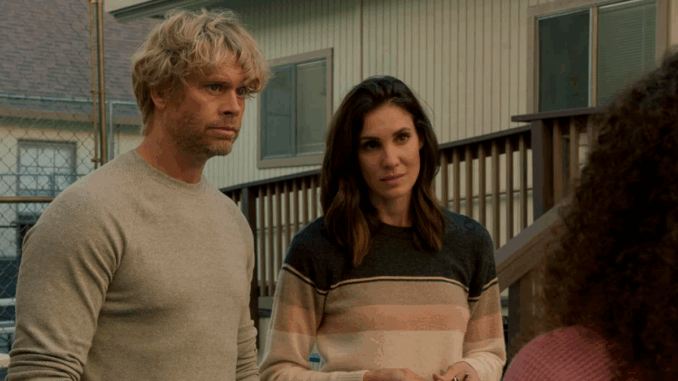
When NCIS: Los Angeles wrapped its 14-season run in 2023, it left behind more than just solved cases and high-octane shootouts. The first official spin-off of the NCIS franchise carved out its own unique identity — part crime procedural, part character drama, and part family story. But what really went on behind the scenes? What made this series so successful for so long, and what truths remained buried beneath its slick action sequences?
Now, two years after its finale aired, we’re peeling back the layers on the untold stories, shocking developments, and lasting legacy of NCIS: LA.
It All Started as a Gamble
Back in 2009, when CBS announced that NCIS would be launching its first spin-off, fans were cautiously optimistic. NCIS had already grown into a massive hit, but could lightning strike twice?
Enter Chris O’Donnell and LL Cool J as Special Agents G. Callen and Sam Hanna — two very different personalities forced to work side-by-side under the Office of Special Projects (OSP) in Los Angeles. From their very first episode, the chemistry was undeniable. “There was a real brotherhood between them, both on and off screen,” recalls executive producer Shane Brennan. “They weren’t just playing partners — they became family.”
The Real-Life Friendships Were Just as Strong
While O’Donnell and LL Cool J were the heart of the series, the full ensemble cast helped cement NCIS: LA as more than just another cop show. Daniela Ruah’s tough-yet-vulnerable Kensi Blye and Eric Christian Olsen’s witty and loyal Marty Deeks gave the series one of TV’s most beloved slow-burn romances. Their on-screen chemistry was so electric that fans were shocked to discover Ruah is actually married to Olsen’s real-life brother, stuntman David Paul Olsen.
“The fact that we were basically family made every scene feel natural,” Ruah once shared in an interview. “It gave Kensi and Deeks a depth that audiences really connected with.”
Secrets from the Set
The set of NCIS: LA was known for its lighthearted energy and tight-knit cast — but that didn’t mean it was without its challenges. According to insiders, long shoot days, location changes, and an ever-evolving plot meant the cast often had to stay on their toes.
“Sometimes we didn’t know how an arc would end when we started filming it,” Eric Christian Olsen revealed. “There was a lot of trust in the writers — and sometimes improvisation.”
The show’s iconic Mission headquarters? Much of it was built on a massive soundstage in Los Angeles, and despite the high-tech appearance, many of the “computer” screens were added in post-production. “It looked slick on camera, but if you turned the monitors on, half of them were just blank,” joked Barrett Foa, who played tech specialist Eric Beale.
The Departures That Shook the Show
Over the years, NCIS: LA saw its fair share of exits — some expected, some heartbreaking. One of the most emotional was the departure of Miguel Ferrer (Assistant Director Owen Granger), who passed away in 2017 after a battle with cancer. The show honored him with a poignant tribute that left both cast and fans in tears.
Barrett Foa and Renée Felice Smith (Nell Jones) also left in later seasons, citing a desire to explore other creative ventures. Their absence was felt deeply by the cast and audience alike.
Perhaps most notably, the series never fully addressed Hetty Lange’s fate. Played by the inimitable Linda Hunt, Hetty became the soul of the show — mysterious, commanding, and always ten steps ahead. But Hunt’s appearances became more limited in later seasons due to personal and health-related reasons, leaving fans wondering what might have been.
The Real Reason It Ended
After 14 seasons, CBS made the decision to conclude NCIS: LA in 2023. Though it remained a consistent performer in ratings, the network opted to pivot toward new spin-offs like NCIS: Sydney and NCIS: Origins.
Still, the ending wasn’t rushed. The writers gave long-time fans closure — and then some. Callen and Anna’s wedding, Kensi and Deeks embracing parenthood, Sam reconnecting with his father — it was all designed to reflect growth, healing, and family.
“In many ways, we wrote it like a love letter to the fans,” showrunner R. Scott Gemmill said. “We knew this wasn’t just our story. It belonged to millions of people who stuck with us for 14 years.”
Where Are They Now?
Since the finale, many of the stars have moved on to new projects. LL Cool J made a surprise return to the franchise with a guest arc on NCIS: Hawai‘i. Daniela Ruah has stepped behind the camera, directing episodes for FBI: International and Portuguese television. Chris O’Donnell continues his work both on- and off-screen, while Eric Christian Olsen is developing his own production projects.
And while the series may be over, the cast has hinted that they’d be open to future reunions. “There’s more story to tell — always,” LL Cool J teased.
The Legacy Lives On
NCIS: LA was more than just explosions and espionage. It was a story about loyalty, chosen family, and finding purpose in chaos. It was about healing old wounds while protecting others from new ones. It struck a delicate balance — the kind only few shows can achieve.
In the end, the biggest truth about NCIS: Los Angeles is simple: it never really left. In reruns, on streaming, in fan conventions, and in the hearts of millions — the team at OSP still lives on.
And for those of us who watched Callen walk into the sunset or Hetty disappear into the shadows one last time, we’ll always wonder: what’s their next mission?
Whatever it is, we’ll be ready.
